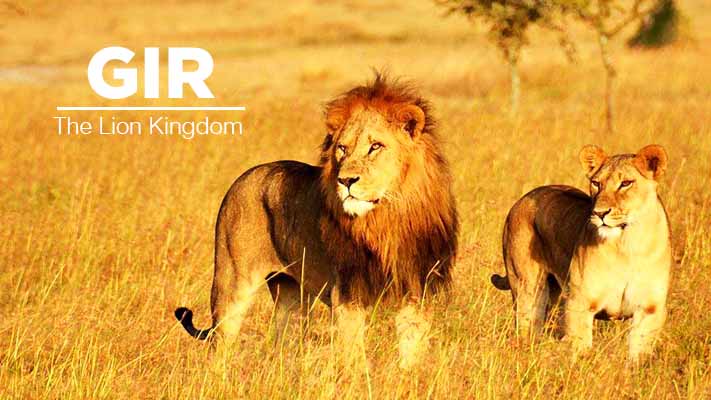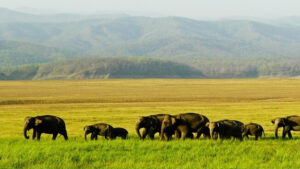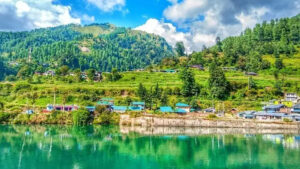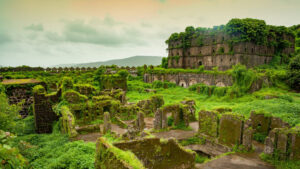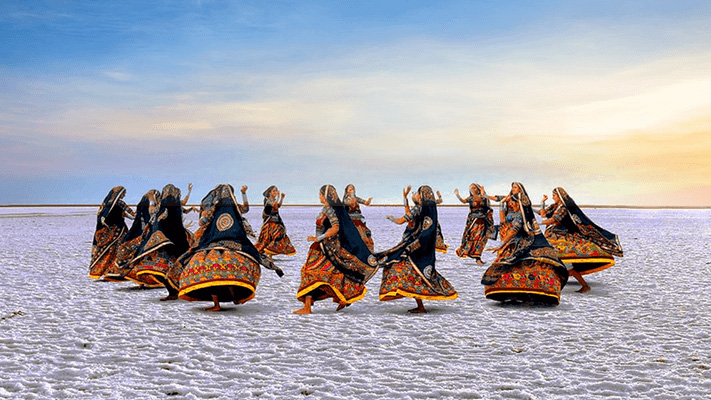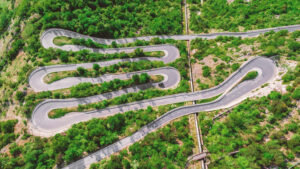GIR NATIONAL PARK, GUJARAT – YOUR CHANCE TO CLOSELY WITNESS THE REGAL ASIATIC LION

Gir National Park is a wildlife sanctuary and national park located in the state of Gujarat in western India. It was established in 1965 and covers an area of 1,412 square kilometers. The park is home to a large population of Asiatic lions, which are an endangered species. It is the only place in the world where Asiatic lions can be found in the wild.

The park consists of a mix of deciduous forest, scrubland, and grasslands, and is home to a variety of other wildlife species, including leopards, hyenas, jackals, deer, antelope, and over 300 species of birds. The park is also known for its crocodile breeding program and is home to several marsh crocodiles and mugger crocodiles.
Visitors to Gir National Park can take guided jeep safaris through the park to see the wildlife up close. There are also several nature trails for hiking and birdwatching. The park is open from mid-October to mid-June, as the monsoon season brings heavy rains and flooding that makes the park inaccessible. It is recommended to visit the park during the dry months of December to March for the best chances of spotting the lions and other wildlife.
Here are some interesting facts about Gir National Park:
1. Gir National Park is the only place in the world where Asiatic lions can be found in the wild. The park is home to over 500 lions.
2. The park was established in 1965 to protect the dwindling population of Asiatic lions, which were on the brink of extinction at the time.

3. The park is also home to several other endangered species, including Indian leopards, Indian pangolins, and Indian star tortoises.
4. It has a large population of marsh crocodiles and mugger crocodiles, which can be seen basking in the sun on the banks of the Kamleshwar Dam reservoir.
5. Gir National Park has a unique ecosystem, with a mix of dry deciduous forest, scrubland, and grasslands. The park is also home to several water bodies, including the Hiran, Shingoda, and Machhundri rivers.
6. The park is a popular destination for wildlife photographers and birdwatchers, with over 300 species of birds found within its borders.
7. The best time to visit Gir National Park is during the dry months of December to March, when the weather is cooler and the wildlife is more active.
8. The park is not only a wildlife sanctuary, but also a cultural destination, with several nearby villages offering a glimpse into the rural lifestyle of the region’s people.
Popular Activities Enjoyed by Tourists
Gir National Park offers a range of activities for tourists to enjoy, including:

1. Jeep Safari: The most popular activity in the park is the jeep safari. Visitors can book a guided tour through the park in a 4×4 vehicle, allowing them to get up close and personal with the wildlife.
2. Birdwatching: With over 300 species of birds found in the park, it’s a great destination for birdwatchers. Visitors can spot rare species like the Indian Pitta, White-bellied Minivet, and Painted Sandgrouse.
3. Wildlife Photography: Gir National Park is a popular destination for wildlife photographers. Visitors can capture stunning images of the park’s diverse wildlife, including lions, leopards, and crocodiles.
4. Nature Trails: The park has several nature trails for visitors to explore. These trails offer a chance to see the park’s flora and fauna up close, as well as to enjoy a peaceful walk in nature.
5. Crocodile Breeding Centre: The Kamleshwar Dam reservoir in the park is home to a crocodile breeding center. Visitors can learn about the conservation efforts being made to protect these endangered species.
6. Cultural Tours: Visitors can take a cultural tour of the nearby villages to learn about the region’s rural lifestyle and traditional crafts, such as weaving and pottery.
Top Attractions and Must See Nearby Places
Here are some of the top attractions and must-see nearby places around Gir National Park:

1. Gir Interpretation Zone: The Gir Interpretation Zone is located near the entrance of the park and offers visitors an opportunity to learn about the wildlife and ecosystem of the park through interactive exhibits.
2. Somnath Temple: The Somnath Temple is located about an hour’s drive from Gir National Park and is one of the 12 jyotirlingas (sacred lingams) of Lord Shiva in India. The temple is located on the Arabian Sea coast and offers stunning views.
3. Kankai Mata Temple: The Kankai Mata Temple is located in nearby Sasan Gir and is dedicated to the goddess Kankai Mata. The temple is situated on a hill and offers panoramic views of the surrounding area.
4. Talala Gir: Talala Gir is a small town located about 20 kilometers from Gir National Park. It is known for its organic farms and produces a variety of fruits and vegetables, including mangoes, chikoo, and papaya.
5. Diu Island: Diu Island is a popular beach destination located about 110 kilometers from Gir National Park. The island is known for its stunning beaches, historic forts, and Portuguese architecture.
6. Junagadh: Junagadh is a historic city located about 70 kilometers from Gir National Park. The city is home to several ancient temples, including the Uparkot Fort, the Mahabat Maqbara, and the Girnar Jain temples.
Best Time to Visit
The best time to visit Gir National Park is between December and March, which is the park’s winter season. During this time, the weather is cooler, and the wildlife is more active. Visitors can expect temperatures to range from 10 to 25 degrees Celsius, making it pleasant for wildlife safaris and other outdoor activities.

The park is closed during the monsoon season, which runs from June to October, due to heavy rainfall and the risk of flooding. The summer months of April and May can also be quite hot, with temperatures reaching up to 40 degrees Celsius, making it less comfortable for visitors to explore the park.


